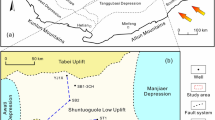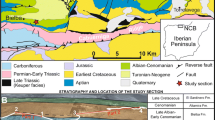Abstract
Detailed sedimentological analysis of the Jurassic (Bajocian-Callovian) Chiltan Formation has been accomplished from the Middle Indus Basin, Pakistan. We have discriminated six different microfacies that deciphered a carbonate barrier-inlet shelf platform depositional setting. These facies represented the lagoonal tidal inlets (CHF 1 facies), carbonate shoals (CHF 2 facies), fore shore (CHF 3 facies), supra tidal (CHF 4 facies), wash over fans (CHF 5) and near shore (CHF 6 facies) setting. The record of the smaller benthic foraminifera (Lenticulina subalta, lenticulina vobulus and planularia protracta) confirms a middle Jurassic (Bajocian-Callovian) age of the unit. This biostratigraphic calibration suggests that the deposition of the Chiltan Formation correspond to a second order cycle (17 Ma) which encompasses a composite transgressive systems tract and various third order cycles and systems tracts. The long and short term sea level fluctuations show a close match with global sea level curve.
Access provided by Autonomous University of Puebla. Download conference paper PDF
Similar content being viewed by others
Keywords
1 Introduction
The studied area is located in the north-eastern part of the Middle Indus Basin (Fig. 1) which comprises several units formed during Middle Jurassic to Pliocene. The Chaman Fault bounds the Sulaiman fold and thrust belt to the north and west; whereas, the Indus plain marks the southern and eastern limits of the active fore deep basin.
In this study we have combined fieldwork investigations and a detailed petrographic analysis for the microfacies characterization, depositional environments, and the sequence interpretation of the Chiltan Formation.
2 Materials and Methods
The detailed outcrop investigtaion resulted in the construction of a composite stratigraphic log and detailed petrography (based on the study of the rock samples). The microscopic analysis of the carbonate rock samples is based on the identification of microfacies types that can be identified by using the limestone composition, depositional texture and fossil distribution of specific samples. The sequence stratigraphy is based on the integration of sea level changes deduced from the facies interpretations supported by the foraminiferal biostratigraphic framework.
3 Results
3.1 Facies and Paleoenvironments
Various facies have been recognized which represent deposition under shallow shelf conditions (Tidal flats) as seen in the Dampier basin, North West shelf, Australia. The Chiltan Formation has been deposited on a carbonate barrier inlet system (shelf) as it mainly consists of pure limestone facies. The bioclastic peloidal grainstone facies (CH F1) was deposited in the lagoonal tidal inlets and the mudstone facies (CH F4) shows a supra tidal environment. The deposition of miliolid bearing intraclastic peloidal grainstone facies (CH F5) occurred in the wash over fan and spicules bearing peloidal ooidal grainstone (CH F2) facies dominated the carbonate shoals. The ooidal peloidal intraclastic grainstone facies (CH F3) have indicated the fore-shore while the bioclastic intraclastic peloidal grainstone facies (CH F6) were being deposited in the near-shore zone (Fig. 2).
The composite sequence stratigrapic chart is based on the integration of outcrop data (Lithostratigraphc logs), facies information, depsitional settings, nature of depositional cycles, sequences, systems tracts and comparison of relative and eustatic sea level during Bajocian-Callovian time in the study area
4 Discussion
The Chiltan Formation is characterized by a variety of faunal constituents that include smaller benthic foraminifera, echinoderms, bivalves, gastropods, sponge spicules, brachiopods, algae, and radiolarians. However, on the basis of smaller benthic foraminifera, the Chiltan Formation was assigned a middle Jurassic (Bajocian-Callovian) age. The Lenticulina subalta, lenticulina vobulus and planularia protracta association was recognized from the Chilton Formation which is a characteristic fauna of the Bajocian-Callovian age. Based on these data, the Chilton Formation is interpreted to have been deposited during a time span of 17 Ma. The numerical ages are assigned and the second order of cyclicity is interpreted. The relative sea level curve of the Chiltan Formation is constructed by the recognition of various facies types and its depositional settings. In long term, the sea level curve of the Chiltan Formation corresponds to one episode of sea level rise. This is recognized as a second order cycle which consists of composite transgressive tract systems. In the short term, the relative sea level curve shows two episodes of sea level rise and fall of a third order cycle. In long term, a sea level rise in the Bajocian and fall during the Bathonian followed by a rise in the Callovian. It is noted that it extends to the Oxfordian (Fig. 2). In long term, the global sea levels remained generally low in the middle Jurassic, rising somewhat in the Bajocian but falling again in the late Bathonian. The trend reversed itself in the Callovian. The long-term sea level continued to rise through the Oxfordian it reaches the peak in the Kimmeridgian (Fig. 2).
5 Conclusion
The sea level fluctuations observed in the Chilton Formation are in harmony with the long term global fluctuations [1]. In short terms, two episodes of sea level rises and falls have been observed in the Chiltan Formation while the Haq curve [1] contains three episodes of rise and fall. The absence of one episode of sea level rise and fall in the Chiltan Formation may be attributed to the local tectonics.
Reference
Haq, B.U., Hardenbol, J., Vail, P.R.: Chronology of fluctuating sea levels since the Triassic. Science 2(35), 1153–1165 (1987)
Author information
Authors and Affiliations
Corresponding author
Editor information
Editors and Affiliations
Rights and permissions
Copyright information
© 2019 Springer Nature Switzerland AG
About this paper
Cite this paper
Ahmad, S., Wahab, A., Khan, S., Sadiq, M., Qureshi, K., Khan, Z. (2019). Integrated Sequence Stratigraphy of the Middle Jurassic (Bajocian-Callovian) Chiltan Formation in the Lower Indus Basin, Pakistan. In: Boughdiri, M., Bádenas, B., Selden, P., Jaillard, E., Bengtson, P., Granier, B. (eds) Paleobiodiversity and Tectono-Sedimentary Records in the Mediterranean Tethys and Related Eastern Areas. CAJG 2018. Advances in Science, Technology & Innovation. Springer, Cham. https://doi.org/10.1007/978-3-030-01452-0_40
Download citation
DOI: https://doi.org/10.1007/978-3-030-01452-0_40
Published:
Publisher Name: Springer, Cham
Print ISBN: 978-3-030-01451-3
Online ISBN: 978-3-030-01452-0
eBook Packages: Earth and Environmental ScienceEarth and Environmental Science (R0)






